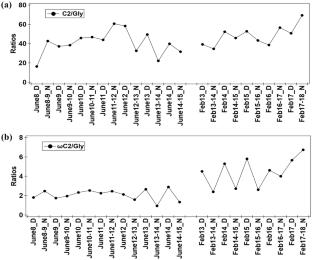Water-soluble dicarboxylic acids, oxoacids and α-dicarbonyls in the tropical aerosols in coastal megacity Mumbai: molecular characteristics and formation processes
Abstract
Abstract
Daytime and nighttime PM10 samples were collected during summer (June) and winter (February) at a representative urban site in Mumbai, located on the western coast of Indian subcontinent. Samples were studied for molecular distribution of water-soluble dicarboxylic acids, oxoacids and dicarbonyls as well as total carbon (TC), water-soluble organic carbon (WSOC), inorganic ions along with specific markers (levoglucosan, K+) to better understand sources and formation processes of organic aerosols in Mumbai. The distribution of water-soluble organics was characterised by high abundance of oxalic acid (C2), followed by phthalic (Ph), terephthalic (tPh), azelaic (C9), malonic (C3), and succinic acids (C4). Positive correlations between C2, sulfate and glyoxal (ωC2) suggest secondary production of C2 predominantly via aqueous phase chemistry. C2 also showed positive correlation with K+ and levoglucosan indicating that biomass/biofuel burning is the potential source of diacids in the Mumbai aerosols. In addition, higher average contributions of total diacids to WSOC and OC in winter than in summer suggest that aerosols were aged i.e., photochemically well processed in winter in Mumbai. On the other hand, diurnal change in their ratios is observed with higher ratio in daytime samples than that of previous and succeeding nighttime samples, suggesting diacids are also influenced from local sources in both the seasons. This study demonstrates that biomass burning as well as biogenic sources are important sources influencing the distributions of aerosols in Mumbai.


 求助内容:
求助内容: 应助结果提醒方式:
应助结果提醒方式:


